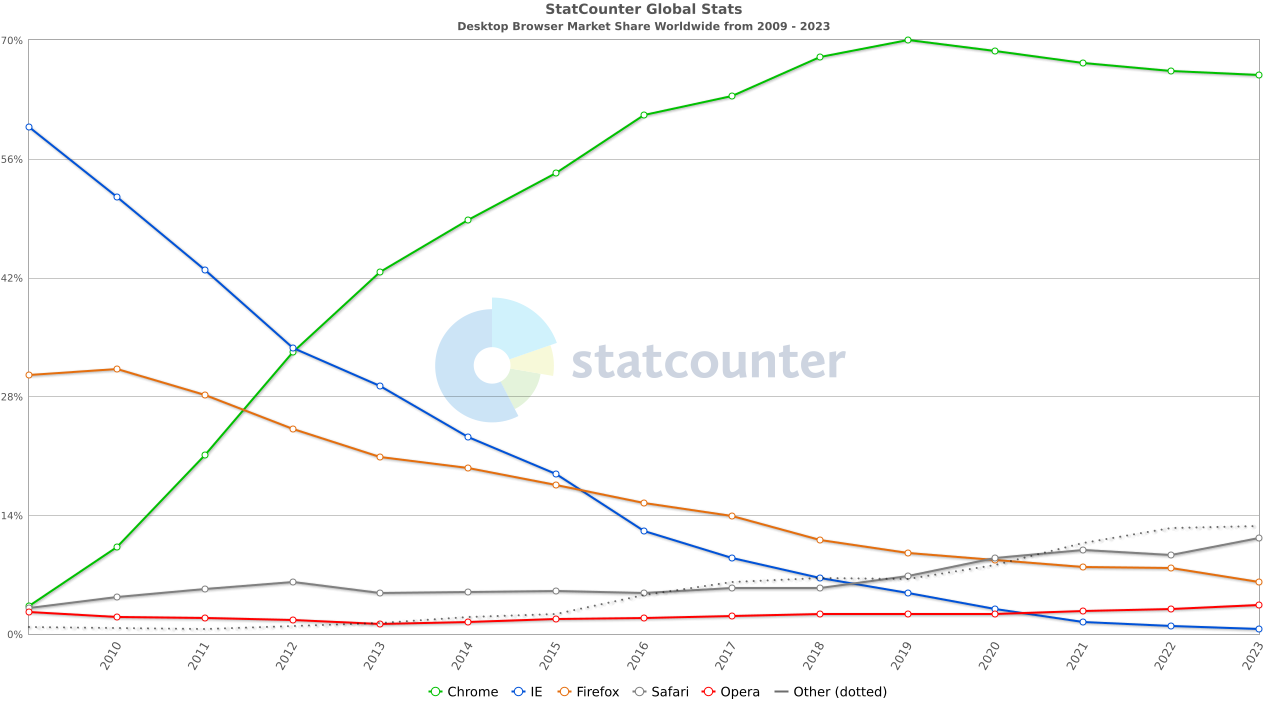Thoughts on the fading away of the age of IE
Nowadays, as it pleased most frontend engineers, making web pages/applications compatible with IE Browser is not required almost everywhere.
Internet Explorer, especially the lower versions, is inconsistent with W3C standards, barely has developer toolchains, and therefore very hard to debug. But the anti-modern frontend legacy browsers didn’t easily die. If you had checked browser distribution in recent years, you would notice that IE always had a reasonable proportion, not much, but also not in a trend towards zero in a short period.

I have been thinking about two questions for a long time. First, why the market share of IE is so resilient to die? Second, why did IE lose to Chrome from the position of market domination while Windows has always been dominating the desktop OS market? Now I realized that the answers to the two questions are the same — the mechanism of the software update.
No doubt that software needs updates, like adding new features, sunset old features, fixing bugs, etc. With updates available, the software developers have to distribute the updates to the consumers’ side. The distribution process is actually the tricky part. For server-side or enterprise-side software, there won’t be many copies to deal with, and there will be professional engineers to handle, the update process is not that hard. But for consumer-side software, the situation is quite different, there may be millions of copies(billions for Microsoft Windows and IE), and the consumers are mostly on their own, some of the consumers even know nothing about the concept of software updates.
We know that binding IE with Windows is the key to IE’s domination of the browser market. But the distribution of updates for IE is also inextricable with the updates of Microsoft Windows. From the history of IE, we know that IE4 is with Windows 98, IE5 with Windows 98 sp2, and IE6 with Windows XP. There is no Windows Update with those early versions of Windows, to update IE you have to download it yourself, or with a disc even soft disks. The most reliable way of updating IE is always installing the newer version of Windows all over. Not to mention that you had to reinstall the same version of Windows when the installation is broken which restored IE to its default version. Most consumers are reluctant to upgrade their operating systems(maybe only when they buy a new computer). So layers of unable to upgrade ensured that old versions of IE seize a significant amount of market share. This market share can not be ignored, those users can not be abandoned.
So what did Google Chrome do about the updating issue? The early versions of Chrome installed themselves somewhere inside a user directory like “C:\Documents and Settings\username\Local Settings\Application Data\”. Why? Because the location allows Chrome to upgrade itself without users even knowing, a user of Chrome always uses the latest version of Chrome. All new features and patches are applied to Chrome, not a specific version of Chrome.
Along with Chrome, the auto-update mechanism become one of the most important yet the most common features of any popular software. Even cars and refrigerators upgrade their firmware via OTA. But old versions of IE remain there, along with the early generations Internet featured operating systems and computers.
Consider IE the hegemony software of the early Internet age. Hegemony it was, but premature it also was. When the mechanism of auto update prevailed as a sign of the matured software, the premature hegemony IE became an obsolete but weird existence, and the nightmare of frontend developers.
We could draw a conclusion, the fading away of IE is the process of how it is misadapted to the evolving ecology of the software industry.
References: